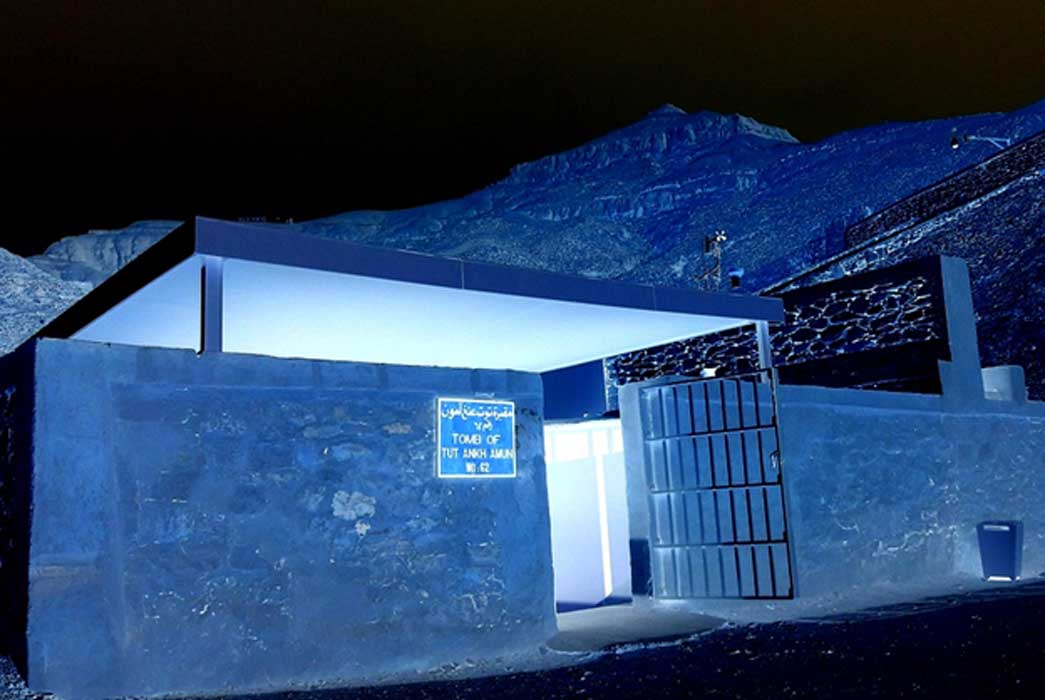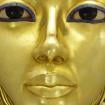KV62, Designed to Confound: Was Tutankhamun’s Tomb built for a Female Pharaoh?—Part I
One of the greatest enigmas in all of Egyptology is the location of the final resting place of Queen Nefertiti, a powerful royal personage of the late Eighteenth Dynasty. Barring pieces of a votive shabti that was probably placed in her husband Akhenaten’s tomb, no funerary object from her burial has ever surfaced. The quasi-royal design of Tomb 26C within the Communal Tomb in Amarna (TA26) provides evidence that it was built for Nefertiti, but the unfinished chambers of this suite hint she was not laid to rest in Akhetaten. This can only mean one thing: Nefertiti’s sepulcher lies elsewhere—and is probably intact.

The Wilbour Plaque is named for the early American Egyptologist Charles Edwin Wilbour (1833–1896), who acquired it in Egypt in 1881. This sculptor’s model depicts Akhenaten and Nefertiti – wearing the khat headdress and ovoid cap crown respectively – and shows the royal couple as equals; which is proof of the extraordinary status enjoyed by the Amarna queen. Brooklyn Museum, New York.
The Tomb of Ankhkheperure?
In his 2015 paper The Burial of Nefertiti? renowned Egyptologist, Dr Nicholas Reeves, proposed an astounding theory that the consort and probable co-regent of Pharaoh Akhenaten lay behind the north wall of the Burial Chamber of Tutankhamun’s tomb in the Valley of the Kings. Apart from studying state-of-the-art scans published by the Spanish group, Factum Arte, Reeves recognized that contrary to the design of royal tombs for males of the Eighteenth Dynasty the crypt of the boy-king was unusual, in that, the Burial Chamber was reached via a right-hand turn. This indicated a prior female owner, said Reeves. So was this tomb adapted from a predecessor for the boy-king’s use?
“The pieces of the jigsaw begin to fall convincingly into place. Evidently the Antechamber and Burial Chamber had originally taken the form not of separate rooms but of a single, extended corridor – a corridor which gives every appearance of proceeding deeper into the gebel, beyond the Burial Chamber’s decorated north wall. This recognition is significant, because if KV 62 had indeed begun its existence as a corridor-tomb its precise form will tell us who, in broad terms, it had originally been commissioned for. In the same way that a leftward orientation characterizes the tomb of a king at this period, a corridor-tomb with rightward axial turn seems to be indicative of queenly use,” explains Reeves.
- The Mysterious Disappearance of Nefertiti, Ruler of the Nile
- Nefertiti and a Rush of Scans: Race to find Double Burial Gathers Steam—Part I

Tutankhamun’s burial chamber, looking in from the Antechamber. Straight ahead, the north wall shows various funerary scenes involving the deceased pharaoh. The modest size of the tomb and inadequate decoration has for long baffled Egyptologists. Luxor.
The location and decoration of royal tombs was highly important to the ancient Egyptians who left no stone unturned in ensuring that the souls of their rulers attained safe passage into the Afterlife. The Instructions for Prince Hardjedef from the Fifth Dynasty are explicit in this regard: “Make good your dwelling in the graveyard, make worthy your station in the West… the house of death is for life.” So it is bizarre that the design of Tutankhamun’s crypt – which Howard Carter termed ‘demi-royal’ – should befuddle so. The incredible wealth of riches that the young king was buried with in the modest four-chambered tomb is staggering. Where did all these treasures come from?
An estimated eighty percent or more of the tomb’s core burial equipment (such as the large gilded shrines, sarcophagus, coffins, gold mask, and canopic assemblage) was re-purposed for Tutankhamun by usurping the funerary goods of two predecessors: Akhenaten and the mysterious woman ruler, Ankhkheperure.

This shabti fragment naming Nefertiti has confounded Egyptologists for decades. Some believe it to be proof of the discovery of her burial; while others contend that it is no more than a votive offering placed in Akhenaten’s tomb. Louvre Museum, Paris.
Reeves proposes that Ankhkheperure was none other than Nefertiti, who, as co-regent, adopted a kingly name: Ankh(et)kheprure Neferneferuaten, and bore the epithet “beneficial for her husband/spouse”. When Akhenaten died during his seventeenth year on the throne, she succeeded him as independent pharaoh, her name now changed to Ankhkheperure Neferneferuaten Smenkhkare-Djeser-Kheperu. “It was presumably at this point, as full king, that Nefertiti’s now outmoded co-regent’s tomb furnishings were set aside – we may assume in favour of something very much better and of fully pharaonic design,” the leading archeologist posits.
- The Elusive Tomb of Queen Nefertiti may lie behind the walls of Tutankhamun's Burial Chamber
- Bust of Contention: Controversy erupts as the Younger Lady is dubbed Nefertiti—Part I

Discovered at Tell el-Amarna, this inlay profile head of red quartzite represents Nefertiti. The lips are painted red in this exquisite artefact, providing further proof that this is an Amarna Period woman. Brooklyn Museum, New York.
Layout and Design of Royal Crypts
Given the right-hand turn feature, is Tutankhamun’s tomb unique? Not all experts concur. Amarna expert, Dr Aidan Dodson, wonders, “who came up with this factoid”. In his Paper, Did Tutankhamun Conceal Nefertiti? , British Egyptologist, Dylan Bickerstaffe, provides strong rebuttals to Reeves’ theory. He writes: “In support of the existence of an additional side chamber in KV62 Reeves points to the fact that King’s Valley tombs of the later 18th Dynasty appear to have aimed to have four such side chambers, ideally one at each end of the Burial Chamber, and one on each side of the Antechamber. Thus this arrangement, which was initiated by Amenhotep II in KV35, was continued by Thutmose IV in KV43, and developed by Amenhotep III in WV22, and Horemheb in KV57. The development, in the two latter cases is that an additional side chamber was added to the Burial Chamber and that one or two of these side chambers were extended to form burial suites for family members. As Reeves notes, the fact that the Entrance Passage of Tutankhamun’s tomb met the side of the Antechamber, rather than the end, meant that there were never likely to have been more than three side chambers in KV62.

Different views of the undecorated KV62 Antechamber shows what Carter called a state of “organized chaos” which was likely due to robberies after the funeral. This room was stocked with approximately 700 priceless objects. (Public Domain: Top left, Top Right, Bottom Left, Bottom Right)
“Reeves’ putative discovery thus raises the side chamber tally in KV62 to the maximum possible, with the acknowledged possibility that the west wall might not simply conceal another storage chamber, but a burial suite for Amarna royalty, perhaps displaced from tombs at Amarna itself. However… it should be acknowledged that Tutankhamun’s tomb came after that of Akhenaten at Amarna (TA26), which only had a single side room opening off the Burial Chamber area (and made provision for other family members in suites opening from the right of the entrance passage); and was followed by the tomb of Ay (WV23) which also had just one side chamber opening from the Burial Chamber.”
There are indeed several examples that serve to disprove that all male royal tombs of the Eighteenth Dynasty show a left turn. “It should be noted that a right-turn into the burial area is not exclusively the preserve of ‘female’ tombs”, explains Dylan. The sepulcher of Thutmose I (KV38), the combined tomb of Thutmose I and Hatshepsut (KV20), the crypt of Aye (KV23), the straight line design of KV55, the tomb of Horemheb (KV57) which indicates a distinct change in the design of royal tombs that carries on into the Nineteenth Dynasty with Ramesses II (KV7). Further, Hatshepsut Meryet-re’s (the wife of Thutmose III) cartouche shaped Burial Chamber (KV42) is aligned to the left in her tomb—and she was, of course, an Eighteenth Dynasty royal female.
- Press Announcement: Radar Scans Reveal Hidden Chamber in Tutankhamun Tomb with 90 Percent Certainty
- More Evidence Supports Claim Hidden Chamber in Tutankhamun Tomb Contains Another Burial

Limestone trial piece showing the head of Nefertiti. This drawing of the Queen, with the lips cut out, was found in the 1890s in Amarna. It shares the iconic features of the Berlin bust. Petrie Museum, London. (Photo: Osama Shukir Muhammed Amin FRCP(Glasg)/CC BY SA 4.0)
Beyond the North Wall
The north wall of the Burial Chamber of Tutankhamun continues beyond to probably more rooms. The murals painted on this “false wall” were a ruse to deflect the attention of robbers, says Dr Reeves, as he throws more light on the topic, “Such corridor concealments were a subterfuge resorted to frequently in the Valley of the Kings, and indeed they occur too within other royal burials elsewhere. All New Kingdom and later instances known to me present depictions of pharaoh in the presence of a variety of gods – the same general subject matter as KV 62’s north wall; and their favoured location was the far side of the tomb’s “well” The evidence cumulatively and compellingly (points) towards the existence of a significantly larger ground plan for KV 62 than has previously been acknowledged. At least two new elements are here proposed: (1) a further storage room on the west of the Burial Chamber, seemingly contemporary with the Annexe and the burial of Tutankhamun; and (2), to the north, an earlier corridor of Antechamber width which continues deeper into the gebel.”
The author expresses his gratitude to Dr Nicholas Reeves and Dylan Bickerstaffe for permitting the use of select extracts from their academic papers.
[The author thanks Dr Chris Naunton and Heidi Kontkanen for granting permission to use their photographs in this series. The public archives of the Metropolitan Museum of Art can be accessed here.]
Top Image: The entrance to KV62, the tomb of Tutankhamun, in the Valley of the Kings; design by Anand Balaji (Photo credit: Anand Balaji); Deriv.
By Anand Balaji
Independent researcher and playwright Anand Balaji, is an Ancient Origins guest writer and author of Sands of Amarna: End of Akhenaten.
--
References:
Nicholas Reeves, The Burial of Nefertiti?, 2015
Dylan Bickerstaffe, Did Tutankhamun Conceal Nefertiti?
Nicholas Reeves and Richard H. Wilkinson, The Complete Valley of the Kings, 2008
Aidan Dodson, Amarna Sunset: Nefertiti, Tutankhamun, Ay, Horemheb, and the Egyptian Counter-Reformation, 2009
Howard Carter and A.C. Mace, The Discovery of the Tomb of Tutankhamen, 1977
Nicholas Reeves, The Amarna Dead in the Valley of the Kings, 2003
Nicholas Reeves, The Enduring Mystery of KV55, 1997
Marianne Eaton-Krauss, The Unknown Tutankhamun, 2016
Nicholas Reeves, The Tombs of Tutankhamun and his Predecessor, 1997
Peter A. Clayton, Chronicle of the Pharaohs: The Reign-by-Reign Record of the Rulers and Dynasties of Ancient Egypt, 2006
Nicholas Reeves, The Complete Tutankhamun: The King, the Tomb, the Royal Treasure, 1990

















